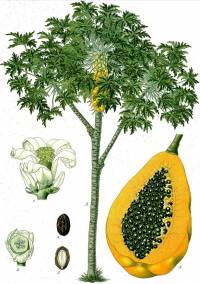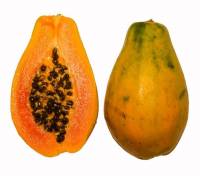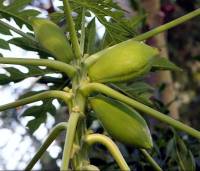The papaya is a small, sparsely branched tree, usually with a single stem growing from 5 to 10 m (16 to 33 ft) tall, with spirally arranged leaves confined to the top of the trunk. The fruit is a large berry about 15–45 cm (5.9–17.7 in) long and 10–30 cm (3.9–11.8 in) in diameter.[6]:88 It is ripe when it feels soft (as soft as a ripe avocado or softer), and its skin has attained an amber to orange hue. Papaya plants grow in three sexes: male, female, and hermaphrodite. The male produces only pollen, never fruit. The female produces small, inedible fruits unless pollinated. The hermaphrodite can self-pollinate since its flowers contain both male stamens and female ovaries. In cultivation, it grows rapidly, fruiting within 3 years. It is, however, highly frost-sensitive, limiting its production to tropical climates. It prefers sandy, well-drained soil, as standing water will kill the plant within 24 hours. The unripe green fruit can be eaten cooked, but not raw due to its poisonous latex content. The ripe fruit of the papaya is usually eaten raw, without skin or seeds.[5] The black seeds of the papaya are edible and have a sharp, spicy taste.


